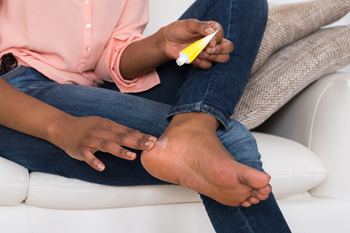Items filtered by date: October 2022
Healing Time for a Broken Ankle

Common ways an ankle can be broken include twisting the ankle beyond its limit or enduring a foot injury. There are noticeable symptoms that accompany a broken ankle. Many people are unable to walk with this type of injury, and there is often immediate pain felt and bruising. In severe breaks, a bone may become displaced where it can look deformed. If a broken ankle is suspected, a proper diagnosis is needed. Generally, this includes having an X-ray taken. Treatment can begin with placing the affected foot in a protective cast or boot, which is a successful method that helps the patient keep weight off the foot. A broken ankle can take up to approximately 12 weeks to completely heal, at which time full range of motion is often restored. A displaced ankle bone may require surgery that can help to put the bone back into its normal position and with this, a longer recovery time may be needed. If you have fractured your ankle, it is advised that you consult a podiatrist who can guide you toward the treatment that is best for you.
Broken ankles need immediate treatment. If you are seeking treatment, contact Dan Kirk, DPM from Bluffton Foot & Ankle. Our doctor can provide the care you need to keep you pain-free and on your feet.
Broken Ankles
A broken ankle is experienced when a person fractures their tibia or fibula in the lower leg and ankle area. Both of these bones are attached at the bottom of the leg and combine to form what we know to be our ankle.
When a physician is referring to a break of the ankle, he or she is usually referring to a break in the area where the tibia and fibula are joined to create our ankle joint. Ankles are more prone to fractures because the ankle is an area that suffers a lot of pressure and stress. There are some obvious signs when a person experiences a fractured ankle, and the following symptoms may be present.
Symptoms of a Fractured Ankle
- Excessive pain when the area is touched or when any pressure is placed on the ankle
- Swelling around the area
- Bruising of the area
- Area appears to be deformed
If you suspect an ankle fracture, it is recommended to seek treatment as soon as possible. The sooner you have your podiatrist diagnose the fracture, the quicker you’ll be on the way towards recovery.
If you have any questions, please feel free to contact our offices located in Bluffton and Celina, OH . We offer the newest diagnostic and treatment technologies for all your foot care needs.
Many Reasons for Foot Pain to Happen

There are common conditions accompanied by foot pain that may be avoided when proper foot care is practiced. Each foot has 26 bones and numerous tendons, ligaments, and muscles, and at any point, pain may occur. Foot pain may result due to a lack of stretching before and after exercise, or from wearing shoes that do not fit correctly. A foot ailment that can bring considerable pain and discomfort is known as plantar fasciitis. Plantar fasciitis may develop from standing on hard surfaces for most of the day. A corn can cause foot pain and generally comes from wearing shoes that are too tight. Additionally, diabetic patients may be prone to foot pain since they are unable to feel existing cuts on the feet, which may ultimately lead to a foot ulcer. Having an ingrown toenail can be uncomfortable for most people and generally needs prompt medical attention before it becomes infected. If you have any type of foot pain, please speak to a podiatrist who can offer you treatment options that bring relief.
Foot Pain
Foot pain can be extremely painful and debilitating. If you have a foot pain, consult with Dan Kirk, DPM from Bluffton Foot & Ankle. Our doctor will assess your condition and provide you with quality foot and ankle treatment.
Causes
Foot pain is a very broad condition that could be caused by one or more ailments. The most common include:
- Bunions
- Hammertoes
- Plantar Fasciitis
- Bone Spurs
- Corns
- Tarsal Tunnel Syndrome
- Ingrown Toenails
- Arthritis (such as Gout, Rheumatoid, and Osteoarthritis)
- Flat Feet
- Injury (from stress fractures, broken toe, foot, ankle, Achilles tendon ruptures, and sprains)
- And more
Diagnosis
To figure out the cause of foot pain, podiatrists utilize several different methods. This can range from simple visual inspections and sensation tests to X-rays and MRI scans. Prior medical history, family medical history, and any recent physical traumatic events will all be taken into consideration for a proper diagnosis.
Treatment
Treatment depends upon the cause of the foot pain. Whether it is resting, staying off the foot, or having surgery; podiatrists have a number of treatment options available for foot pain.
If you have any questions, please feel free to contact our offices located in Bluffton and Celina, OH . We offer the newest diagnostic and treatment technologies for all your foot care needs.
Signs of Cracked Heels

One of the many unsightly and unattractive conditions of the feet is known as cracked heels. Also known as heel fissures or split heel, this condition occurs when the skin on the heel becomes exceedingly dry. There are several signs of cracked heels that you can be on the lookout for. First, the most obvious sign of cracked heels is a developing callus on the heel that can be either a shade of yellow or brown. If the condition is relatively new, you might notice small cracks in the hardened skin callus. However, if this condition is older and has not been treated for a long period of time, then there may be deeper cracks in the callus. These deeper cracks might even bleed in severe cases, inviting infection. If you notice any of these signs, or you believe that you might have cracked heels, do not hesitate to schedule an appointment with a podiatrist today.
Cracked heels are unsightly and can cause further damage to your shoes and feet. If you have any concerns, contact Dan Kirk, DPM from Bluffton Foot & Ankle. Our doctor can provide the care you need to keep you pain-free and on your feet.
Cracked Heels
Cracked heels appear unappealing and can make it harder for you walk around in sandals. Aside from looking unpleasant, cracked heels can also tear stockings, socks, and wear out your shoes. There are several methods to help restore a cracked heel and prevent further damage.
How Do You Get Them?
Dry skin is the number one culprit in creating cracked heels. Many athletes, walkers, joggers, and even swimmers suffer from cracked heels. Age and skin oil production play a role to getting cracked heels as well.
Promote Healing
Over the counter medicines can help, especially for those that need instant relief or who suffer from chronic dry feet.
Wear Socks – Wearing socks with medicated creams helps lock in moisture.
Moisturizers – Applying both day and night will help alleviate dryness which causes cracking.
Pumice Stones – These exfoliate and remove dead skin, which allows for smoother moisturizer application and better absorption into the skin.
Change in Diet
Eating healthy with a well-balanced diet will give the skin a fresh and radiant look. Your body responds to the kinds of food you ingest. Omega-3 fatty acids and zinc supplements can also revitalize skin tissue.
Most importantly, seek professional help if unsure how to proceed in treating cracked heels. A podiatrist will help you with any questions or information needed.
If you have any questions, please feel free to contact our offices located in Bluffton and Celina, OH . We offer the newest diagnostic and treatment technologies for all your foot care needs.
It's Time for Beautiful Feet
Burn Blisters

Many people will develop a blister at one point in their lives due to repeated friction. For example, when wearing an ill-fitting pair of shoes, the material of the shoes might rub against the skin in an uncomfortable way, sometimes creating a blister. Burn blisters, however, develop not in response to friction but in order to protect an area of the skin that has been burned. For instance, a burn blister may develop on the foot after it has suffered a sunburn or second-degree burn of some kind. If you have a burn blister on your foot due to a second degree burn, seek out medical assistance immediately. This is especially true if you notice that there is swelling, redness, or pus around the blister. Of course, it is always important to resist the urge to pop a burn blister, because this increases the likelihood of developing an infection. Contact a podiatrist today for more information about burn blisters.
Blisters are prone to making everyday activities extremely uncomfortable. If your feet are hurting, contact Dan Kirk, DPM of Bluffton Foot & Ankle. Our doctor can provide the care you need to keep you pain-free and on your feet.
Foot Blisters
Foot blisters develop as a result of constantly wearing tight or ill-fitting footwear. This happens due to the constant rubbing from the shoe, which can often lead to pain.
What Are Foot Blisters?
A foot blister is a small fluid-filled pocket that forms on the upper-most layer of the skin. Blisters are filled with clear fluid and can lead to blood drainage or pus if the area becomes infected.
How Do Blisters Form?
Blisters on the feet are often the result of constant friction of skin and material, usually by shoe rubbing. Walking in sandals, boots, or shoes that don’t fit properly for long periods of time can result in a blister. Having consistent foot moisture and humidity can easily lead to blister formation.
Prevention & Treatment
It is important to properly care for the affected area in order to prevent infection and ease the pain. Do not lance the blister and use a Band-Aid to provide pain relief. Also, be sure to keep your feet dry and wear proper fitting shoes. If you see blood or pus in a blister, seek assistance from a podiatrist.
If you have any questions, please feel free to contact our offices located in Bluffton and Celina, OH . We offer the newest diagnostic and treatment technologies for all your foot care needs.

